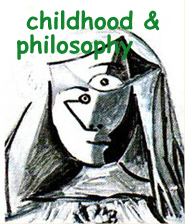developing a method for dialogical analysis of the progress of conceptual thinking in philosophy for children: a first formulation
Keywords:
méthode, interlocution, formalisationAbstract
Any methodological application in the field of philosophy for children implies study of the progression of the thought processes and practical learning capacities. Firstly, from a point of view of the method, which in order to be a valid construction must be based on sound paradigmatic structures and thereby be applicable in practice. These requirements both theoretical and practical are integral and demand together a means of identification of the progression of thought processes, one which is imbued both with a dynamic conception of thought and with a practical conception of learning. The dialectic conflict enables this progression to be charted. It is an essential concept of both the Lipman theories of child philosophy and socio-constructivism, while at the same time remaining in-dissociable from pragmatic linguistics. This federating paradigmatic position is the essential element in constituting a tool which is capable of accounting for the progression of thought in the learning process in the research community. Thereby it becomes possible to conceive of a framework both methodological and conceptual which constructs the dialectic conflict along with the actual dialectic thought, revealing a basic contradiction. The learning process of thought itself therefore reverberates with the exercise of thinking, itself rendered by language as an interlocutory process. This analysis of the progression of conceptual thought in child philosophy can therefore enable the construction of a method only if it is in schematised form and is capable of taking on the cohesion essential to the dialectic conflict. The schematisation of a dialectic progression can therefore be recognised as a tool which enables the constituting process of conceptual thought to be identified. This schematisation is made up of a system of classification marks recording the common denominators making up the prerequisites of thought : differentiation of single and multiple, identical and different, relative and absolute and the part from the whole. This first instalment describes the schematic tool, firstly by presenting the constituting elements, then listing the operative procedures, to conclude with an example of its application. It prefigures a more generalised application which would focus on a methodology which would satisfy more fully the solidarity of its founding requirements. Résumé : Identifier la progression de la pensée, dans la pratique et l’apprentissage du philosopher, constitue une préoccupation inhérente à toute application méthodologique en philosophie pour enfants. Du point de vue de la méthode, tout d’abord, celle-ci exige pour sa validité constitutive de reposer sur une structure paradigmatique autant fondatrice qu’apte à garantir son essence même, soit son applicabilité. L’exigence théorétique et l’exigence pratique s’appellent donc mutuellement pour fonder la nécessité d’un instrument d’identification de la progression de la pensée, qui soit imprégné autant d’une conception dynamique du penser que d’une conception pratique de l’apprendre à penser. Le conflit dialectique permet de structurer cette progression. Il est au coeur autant des fondements lipmanniens de philosophie pour enfants que dans ceux du socioconstructivisme, tout en étant indissociable de toute linguistique pragmatique. Cette position paradigmatique fédératrice en fait le domaine privilégié de la constitution d’un instrument qui soit à mène de rendre compte d’une progression de la pensée dans le processus d’apprentissage de la communauté de recherche. À partir de là, il devient envisageable d’entreprendre la mise en place d’un cadre tant méthodologique que conceptuel qui conçoit le conflit dialectique en solidarité avec la pensée dialectique elle-même, qui se dévoile aporétique. L’apprentissage du penser est ainsi mis en résonance avec l’exercice du penser, lui-même rendu par le langage en communauté interlocutoire. L’analyse interlocutoire de la progression de la pensée conceptuelle en philosophie pour enfants peut donc, sur cette base, permettre la constitution d’une méthode qui, si elle est schématisée formellement, peut être en mesure d’assumer la cohésion fondée par le conflit dialectique. La schématisation d’une progression dialectique apparaît ainsi comme un instrument permettant l’identification du processus constitutif de la pensée conceptuelle. Cette schématisation se compose d’un système de cotation signalant les dénominateurs communs constituant la possibilité même de la pensée : l’un et le multiple, l’identique et le différent, le relatif et l’absolu et enfin la partie et le tout. Ce premier volet présente cet instrument schématique, tout d’abord en exposant son processus constitutif, puis en déroulant son protocole opératoire, pour terminer sur un exemple d’application. Il préfigure une application plus généralisée qui viserait une méthodologie satisfaisant davantage la solidarité de ses exigences fondatrices.Downloads
Download data is not yet available.
Downloads
Published
2009-06-28
How to Cite
HEINZEN, Samuel léo; DUCOTTERD, Jean; HESS, Anne-claude. developing a method for dialogical analysis of the progress of conceptual thinking in philosophy for children: a first formulation. childhood & philosophy, Rio de Janeiro, v. 5, n. 9, p. pp. 53–76, 2009. Disponível em: https://www.e-publicacoes.uerj.br/childhood/article/view/20599. Acesso em: 27 jul. 2025.
Issue
Section
articles




